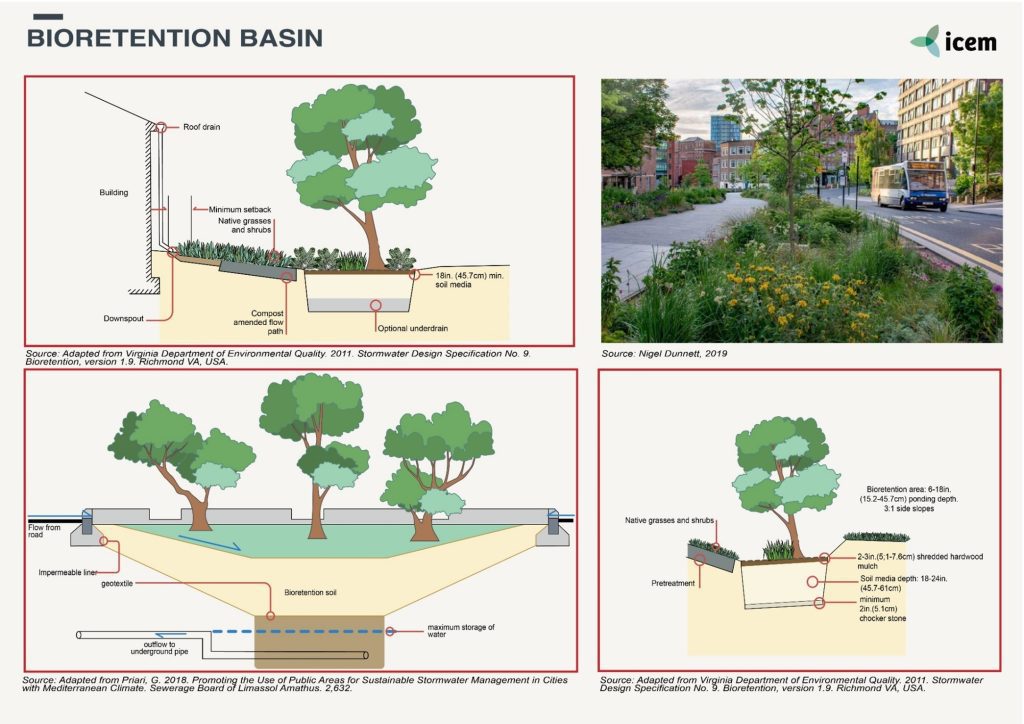| Suburban | Public space | Medium-cost | Pluvial/fluvial flooding | |
| DESCRIPTION | ||||||||||
| Measures
|
Bioretention basins or rain gardens operate in the same way as bioretention swales except that they are not linear and do not convey stormwater but they can provide a detention function. They are effective at treating pollutants from surface runoff from roads, car parks and roof areas before discharge to receiving water bodies. The runoff passes through the densely vegetated surface which provides treatment by filtering and nutrient processing and then percolates down through a filter media and a saturated zone which provides plants with access to water during extended periods of dry weather. A wide range of vegetation can be used allowing them to be integrated into the surrounding landscape and within urban features such as medians, parking bays, and planting beds. In addition to their environmental use, rain gardens provide attractive landscaping and a natural habitat for birds, bees, and butterflies, while encouraging responsible environmental behavior and community pride. Swales can be used upstream of bioretention systems to provide additional pre-treatment
Water quality swales are essentially bioretention cells that are configured as linear channels, usually having a longitudinal slope, with check dams to break to swale in “cells,” and being covered with turf, herbaceous plants, or other surface material. |
|||||||||
| Location | Bioretention basins are very effective at treating pollutants from surface runoff originating from roads, car parks and roof areas before entering sensitive receiving waters. They can be distributed along a project at regular intervals to treat runoff near its source or can be located at outfalls of a drainage system to provide treatment for larger areas. They are however susceptible to clogging of the filter media, so appropriate upstream protection using a sediment basin or other primary treatment such as a buffer strip or gross pollutant trap should be considered. A wide range of vegetation can be used allowing them to be integrated into the surrounding landscape and within features such as medians, traffic calming elements, parking bays, and planting beds. See Design options for more detail on their ideal positioning. | |||||||||
| Design options and performance | Bioretention systems are highly flexible in their design and size, but the following site conditions provide some design constraints:
● Bioretention systems are best located on flat or gently sloping locations and are not suitable for steep slopes greater than 4%. If the site is sloping then the bioretention systems should be made smaller and designed as stepped systems; ● They are not well suited to large catchments (> 2.5 ha) as large sediment loads can choke plants and clog the filter media. In addition, high-velocity flows can result in scour of the bioretention surface. For larger catchments additional infrastructure for sediment capture and energy dissipation should be considered. ● Large single cell large systems (< 500 m2) can be difficult to construct and also have a higher risk of operational issues including difficulty in establishing and maintaining vegetation, scour from high velocity flows, clogging, soil moisture gradients, uneven flow distribution and poor amenity. Systems needing over 500 m2 in size should be broken into smaller cells. |
|||||||||
| Feasibility criteria
|
Available space: Planners and designers can assess the feasibility of facilities based on a simple relationship between the contributing drainage area (CDA) and the corresponding required surface area. The Bioretention area will usually be approximately 3 to 6% of the CDA. Bioretention cells work best with smaller CDAs, where it is easier to achieve flow distribution over the filter bed. Typical drainage area can range from 0.04 to 1.0 hectares) and consist of up to 100% impervious cover. Drainage areas to smaller bioretention practices (urban bioretention) typically range from 0.2 hectares to 0.4.
Site topography: Bioretention can be used for sites with a variety of topographic conditions but is best applied when the grade of the area immediately adjacent to the bioretention practice (within approximately 4-6 meters) and is greater than 1% and less than 5%. For sites with steep grades, bioretention should be split into multiple cells with adequate conveyance between the cells to take advantage of relatively flat areas and/or areas in cut sections. Setbacks: To avoid the risk of seepage, do not allow bioretention areas to be hydraulically connected to structure foundations. Setbacks to structures vary based on the size of the bioretention design: ● O—0.2 ha CDA = 3 meters if down-gradient from building; 15.2 m if up-gradient. ● O.2 – 1.0 ha CDA = 7.6 meters if down-gradient from building; 30.5 m if up-gradient. ● If an impermeable liner and an underdrain are used, no building setbacks are needed for urban bioretention (e.g., stormwater planters) and residential rain garden designs. ● At a minimum, bioretention basins should be located a horizontal distance of 30.5 meters from any water supply well, and 15.2 meters if the bioretention practice is lined. Surface ponding area: the ponding surface area can be larger than the surface area of the soil media according to the following guidelines: ● If the ponding depth is less than 30.5 cm the ponding surface area can exceed the soil media surface area by up to 50 percent. ● If the ponding depth is 30.5 cm or more (up to 0.5 m) the ponding surface area can exceed the soil media surface area by up to 25%. ● The surface ponding volume determination should take into account surface side slopes and can be computed using the following equation: Surface ponding volume = (SA x d ponding) Maximum ponding surface area to soil media surface area ratios
Bioretention Sizing for larger storms (local detention criteria) The design volume can be counted toward storage that may be required to comply with local peak flow or detention requirements on small-sized sites. it should be noted that all site designs should include provisions for the safe conveyance of larger flows either contained within properly sized pipe or channel systems or as overland flood routing to a receiving water body to minimize public safety risks and property damage. Pre-treatment Several pre-treatment measures are feasible, depending on the type of bioretention practice and whether it receives sheet flow, shallow concentrated flow or deeper concentrated flows. For pre-treatment structures at the edge of pavement (e.g. grass filter strips, gravel diaphragms, flow splitters), there must be a 5-10 cm drop from the edge of pavement to the top of the grass or stone in the pre-treatment structure. This is to prevent the accumulation of debris and subsequent clogging at the point where runoff is designed to enter the pre-treatment structure. Technical design: When designing a bioretention system the size is influenced by rainfall characteristics, catchment size, land use, presence or absence of rainwater tanks, extended detention depth, filter media, saturated hydraulic conductivity and depth. Stormwater runoff software is a useful tool in the design process. With regard to shape, their design can be flexible but safety aspects should be considered for pedestrians and vehicular traffic. Bio-retention basins typically contain the following components: ● Inlet area, which may incorporate an area for settling coarse sediment ● Densely vegetated surface and side slopes ● Shallow ponding area of variable depth which provides storage and settlement ● Filter zone of 30 to 100 cm thickness with engineered soil composition. ● Transition layer of 10 cm thickness comprising a layer of well-graded sand for drainage and soil aeration ● 10 cm thick underdrain layer of fine aggregate with inlaid pipes to remove treated water to the storm drain system or receiving water body. ● Outlet structure, which diverts high flows to the local stormwater network Soil media: Should be designed to support vegetation and nutrient uptake, support water storage and include some clay to adsorb pollutants such as hydrocarbons, heavy metals and nutrients. Soil slope: should not be constructed on slopes greater than 4%. Surface cover: water-tolerant plants and grasses. Materials: Excavation equipment, sandy loam soil for filter media, well-graded sand for the transition layer, fine aggregate for the drainage layer, pipework and plants. |
|||||||||
| Operation and maintenance | Bioretention basins should be regularly checked to inspect and flush the pipework, remove litter/debris and ensure that the filter material does become blocked. The vegetation also needs to be regularly monitored to ensure that it is healthy, and a schedule is made for the replacement of the mulch layer and spiking/scarifying the soil media. | |||||||||
| Cost and benefits | Medium cost measure. Bioretention systems capture and detain frequent flow events as water is filtered through the system and as a result of the flow detention, the peak volume of stormwater entering the stormwater networks is reduced which helps to reduce flooding. They also provide effective treatment of stormwater, by removing fine sediments, metals, particulate and dissolved nutrients. The water is retained in the soil media and provides evapotranspiration through the vegetation thus providing local microclimate benefits. They also infiltrate flows into the surrounding soils which further reduces the peak volume of flows entering the stormwater network. | |||||||||
| Design solution | Bioretention basins are designed to filter stormwater runoff through densely planted surface vegetation and then percolate the runoff through a prescribed filter media in which pollutants are retained through fine filtration, adsorption and some biological uptake. The vegetation is a vital element of the system and facilitates the transport of oxygen to the soil and enriches soil microbial communities which then enables the biological transformation of pollutants. Stormwater is collected in the filter media in perforated under-drains and discharged to receiving waterways or to storage for potential reuse. However, where the in-situ soils allow and if there is a particular design intention to recharge local groundwater, stormwater can be allowed to infiltrate from the base of a filter media to underlying in-situ soils. | |||||||||
| Sources | ● AECOM/Townsville City Council. 2011. WSUD Technical Design Guidelines for the Coastal Dry Tropics: Bioretention Basin.
● CIRIA. 2015. The SuDS Manual. Chapter 15, Bioretention Systems. ● Jarrett, A. 2016. Rain Gardens (Bioretention Cells) – A Stormwater BMP. Pennsylvania State University. ● Melbourne Water, 2005. WSUD Engineering Procedures: Stormwater. ● Susdrain. Not dated. Delivering SuDS – Detention Basins. |
|||||||||
Originally developed under the ADB ‘TA-9417 VIE: Secondary Green Cities Development Project – Output 2: Demonstrated sustainable and resilient development in Hue, Ha Giang and Vinh Yen’. Adapted for the UN-CTCN project ‘Climate risk assessment for subnational adaptation and establishment of a local climate information system for climate change adaptation (LISA) in Cambodia’.



